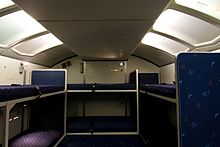Crew rest compartment
A crew rest compartment (crew rest) is section of an airliner dedicated for breaks and sleeping by the staff.

Crew rests may be located above or adjacent to the passenger compartment.[1] Crew rest compartments are normally segregated, with separate compartments for the flight crew and the cabin crew.[2]
On long flights, crew members may sleep in the crew rests during their break periods.[3] Federal Aviation Regulations have provisions requiring crew rest areas be provided in order to operate a long flight by using multiple crew shifts.[4]
Passengers are restricted from accessing crew rest compartments by regulations, additionally their entrances may be secured by locks and may require ascending a ladder to access.[5]
Crew rests compartments may not normally be used during taxi, takeoff, or landing maneuvers (TT&L).[6] In flight crew rests that contain standard seats, an exception may be made to allow seated crew during TT&L.[7]
The Federal Aviation Administration defines three classes of crew rest facilities, the types required to be available depend on the number of crew and the duration of the flight.[8] Crew rest periods may be provided in higher classed rest areas then required, for example some airplanes may not have a class 2 rest facility, providing breaks in a crew rest.
Rest facility classifications from highest to lowest:
- Class 1 rest facility: This class requires access to an area physically separated from the flight deck and the passenger cabin; contain bunks or other flat areas for sleeping; have provisions for sound and lighting isolation.
- Class 2 rest facility: This class requires access to at least a lie flat seat and separation from passengers by a curtain.
- Class 3 rest facility: This class only requires a cabin seat that is able to recline and has foot support.
Aircraft with crew rest compartment
References
- ^ Schneider, Kate. "Inside the part of the plane you can't see". news.com.au. Retrieved 26 July 2016.
- ^ "Federal Register | Special Conditions: Airbus, Model A350-900 Series Airplane; Crew Rest Compartments". www.federalregister.gov.
- ^ www.catchmeifyoucannie.com, Annie Kingston (21 January 2016). "The Reality Of Being A Flight Attendant". The Huffington Post. Retrieved 26 July 2016.
- ^ George, Fred. "Preventing Crew Fatigue from A to Zzz". aviationweek.com. Business & Commercial Aviation. Retrieved 26 July 2016.
- ^ Brown, David (13 October 2014). "Inside Look: Crew Rest Areas on Different Airliners - AirlineReporter". Airline Reporter. Retrieved 26 July 2016.
- ^ "Federal Register | Special Conditions: Airbus, A350-900 Series Airplane; Crew Rest Compartments". www.federalregister.gov.
- ^ "Special Condition D-04" (PDF).
- ^ "Advisory Circular AC 117-1" (PDF). Federal Aviation Administration. Retrieved 26 July 2016.
